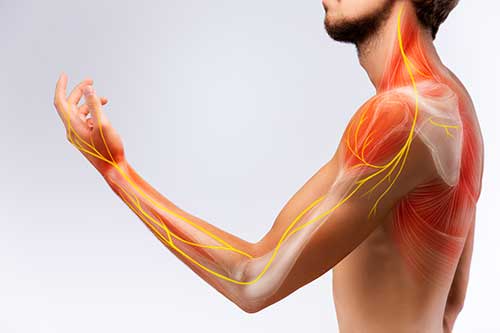NERVE DISORDERS

Many of us have experienced severe burning, numbness, and tingling after hitting our “funny bone.” This is caused by trauma to the ulnar nerve at the elbow. Similar discomfort may be brought on by sleeping on an arm or leg in a funny position.
The brain and spinal cord are considered the Central Nervous System. Incoming and outgoing information travel in the nerves of the arm similar to a telephone wire. These nerves are considered the Peripheral Nervous System. Information regarding the environment such as hot, cold, and the position of our pen are carried on sensory nerves. Motor nerves carry bioelectrical information to muscle, resulting in contraction and movement.
The perception of pain varies with each individual; terms such as stabbing, prickling, burning, tingling, and other descriptions have been used. Nerve pain is difficult to live with but in most individuals, it can be reduced. Nerve pain is also called neuropathic pain.
- Neuropathy is the disease of the nervous system in which there is a disturbance in the function of a nerve or particular group of nerves. The three major forms of nerve damage are: peripheral neuropathy, autonomic neuropathy, and mononeuropathy. The most common form is peripheral neuropathy, which mainly affects the feet and legs.
- Sciatica is pain, tingling, or numbness produced by an irritation of the sciatic nerve. Sciatica is a pain in the leg due to irritation of the sciatic nerve. Sciatica most commonly occurs when a branch of the sciatic nerve is compressed at the base of the spine.
- Carpal tunnel syndrome occurs when tendons in the wrist become inflamed after being aggravated. Tendons can become aggravated when the carpals (a tunnel of bones) and the ligaments in the wrist narrow, pinching nerves that reach the fingers and the muscle at the base of the thumb.
- Polyneuropathy is any illness that attacks numerous nerves in the body, sometimes causing weakness and/or pain. It tends to be a systemic problem that affects more than one nerve group at a time. Polyneuropathies are relatively symmetric, often affecting sensory, motor, and vasomotor fibers simultaneously.
- Diabetic neuropathies are neuropathic disorders that are associated with diabetes mellitus. These conditions usually result from diabetic microvascular injury involving small blood vessels that supply nerves (vasa nervorum).
- Postherpetic neuralgia is pain that persists after an episode of shingles (herpes zoster) has resolved, resulting from damaged nerve fibers from the shingles.
- Thoracic outlet syndrome is a condition in which the nerves or vessels behind the collar bone (clavicle) become compressed or stretched, causing pain, weakness, or numbness in the arm on the same side. The thoracic outlet is an area at the top of the rib cage, between the neck and the chest. Several anatomical structures pass through this area, including the esophagus, trachea, and nerves and blood vessels that lead to the arm and neck region.
